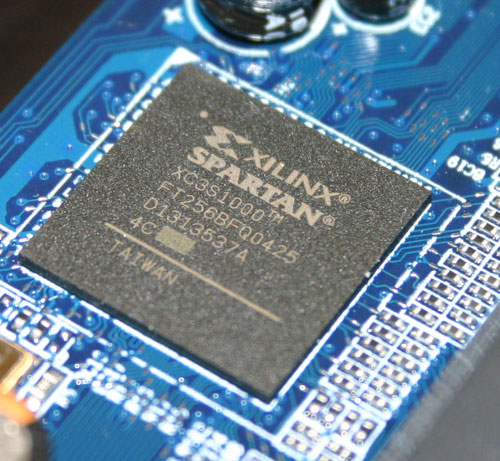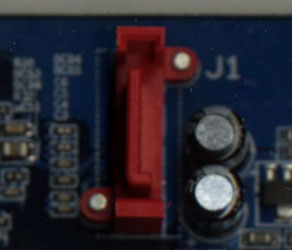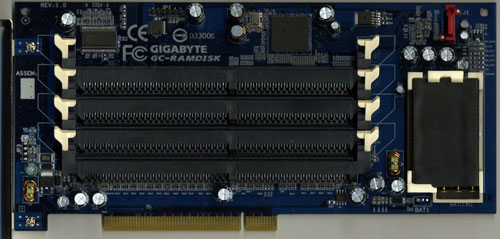Gigabyte's i-RAM: Affordable Solid State Storage
by Anand Lal Shimpi on July 25, 2005 3:50 PM EST- Posted in
- Storage
We All Scream for i-RAM
Gigabyte sent us the first production version of their i-RAM card, marked as revision 1.0 on the PCB.There were some obvious changes between the i-RAM that we received and what we saw at Computex.
First, the battery pack is now mounted in a rigid holder on the PCB. The contacts are on the battery itself, so there's no external wire to deliver power to the card.


The Xilinx FPGA has three primary functions: it acts as a 64-bit DDR memory controller, a SATA controller and a bridge chip between the memory and SATA controllers. The chip takes requests over the SATA bus, translates them and then sends them off to its DDR controller to write/read the data to/from memory.
Gigabyte has told us that the initial production run of the i-RAM will only be a quantity of 1000 cards, available in the month of August, at a street price of around $150. We would expect that price to drop over time, and it's definitely a lot higher than what we were told at Computex ($50).
The i-RAM is outfitted with 4 184-pin DIMM slots that will accept any DDR DIMM. The memory controller in the Xilinx FPGA operates at 100MHz (DDR200) and can actually support up to 8GB of memory. However, Gigabyte says that the i-RAM card itself only supports 4GB of DDR SDRAM. We didn't have any 2GB unbuffered DIMMs to try in the card to test its true limit, but Gigabyte tells us that it is 4GB.
The Xilinx FPGA also won't support ECC memory, although we have mentioned to Gigabyte that a number of users have expressed interest in having ECC support in order to ensure greater data reliability.
Although the i-RAM plugs into a conventional 3.3V 32-bit PCI slot, it doesn't use the PCI connector for anything other than power. All data is transfered via the Xilinx chip and over the SATA connector directly to your motherboard's SATA controller, just like any regular SATA hard drive.

With SATA as the only data interface, Gigabyte made the i-RAM infinitely more useful than software based RAM drives because to the OS and the rest of your system, the i-RAM appears to be no different than a regular hard drive. You can install an OS, applications or games on it, you can boot from it and you can interact with it just like you would any other hard drive. The difference is that it is going to be a lot faster and also a lot smaller than a conventional hard drive.
The size limitations are pretty obvious, but the performance benefits really come from the nature of DRAM as a storage medium vs. magnetic hard disks. We have long known that modern day hard disks can attain fairly high sequential transfer rates of upwards of 60MB/s. However, as soon as the data stops being sequential and is more random in nature, performance can drop to as little as 1MB/s. The reason for the significant drop in performance is the simple fact that repositioning the read/write heads on a hard disk takes time as does searching for the correct location on a platter to position them. The mechanical elements of hard disks are what make them slow, and it is exactly those limitations that are removed with the i-RAM. Access time goes from milliseconds (1 x 10-3) down to nanoseconds (1 x 10-9), and transfer rate doesn't vary, so it should be more consistent.
Since it acts as a regular hard drive, theoretically, you can also arrange a couple of the i-RAM cards together in RAID if you have a SATA RAID controller. The biggest benefit to a pair of i-RAM cards in RAID 0 isn't necessarily performance, but now you can get 2x the capacity of a single card. We are working on getting another i-RAM card in house to perform some RAID 0 tests. However, Gigabyte has informed us that presently, there are stability issues with running two i-RAM cards in RAID 0, so we wouldn't recommend pursuing that avenue until we know for sure that all bugs are worked out.












133 Comments
View All Comments
crazySOB297 - Monday, July 25, 2005 - link
I'm surprised they didn't raid a few of them... I think you could get some huge performance.Googer - Tuesday, July 26, 2005 - link
Not to mention it is a way to also get around the 4gb siza limitation.
Hacp - Monday, July 25, 2005 - link
Dude the article said straight out that SATA150 was the only format supported. Read the entire article.Guspaz - Monday, July 25, 2005 - link
I too am dissapointed that the article lacked any mention of SATA2, which is twice as fast as SATA (300MB/s vs 150MB/s). Considering many motherboards already on the market suport SATA2, and the 300MB/s transfer rate that goes with it, it is a bit of an oversight that the articles doesn't even MENTION if the card supports SATA2 or not. Nor do they mention what they think would happen with SATA2, or if Gigabyte is likely to produce a SATA2 version. It's a weak spot in this article, I think, considering how central the bandwidth of SATA is to the performance of the i-RAM.snorbert - Tuesday, July 26, 2005 - link
33MHz PCI only gets you 133 MB/sec theoretical, and more like 110 MB/sec in the real world. The i-RAM with SATA 1 can completely saturate a PCI bus. SATA2 would cost more to implement, and give you no speed increase at all on a 33MHz bus. If you build the card for higher-end PCI specs (e.g. 66MHz, 64 bit, 66MHz/64bit, PCI-X) then you automatically exclude most PC enthusiasts (unless they like buying server boards for their game boxes).
If they end up doing a PCI Express version, then there would be some reason to support SATA2.
This board is not a replacement for a hard drive. It would be incredibly useful as a transaction log though. Reliable (i.e. won't get lost if the machine crashes) write-behind caching for RAID 5 drives will give you a huge boost to write speeds. And the controller cards that support battery-backed write behind caching cost a lot more money than an i-RAM.
-Jason
sprockkets - Tuesday, July 26, 2005 - link
Also to reply hereKeep in mind that for many years the ide/sata controllers are NOT on the PCI bus of the southbridge, so PCI is not a limitation.
snorbert - Tuesday, July 26, 2005 - link
Actually, scratch my comment - I had not had enough coffee when I wrote it. I forgot that the PCI connector is doing essentially squat except providing power to this device. Of course you could have a SATA2 controller on a faster bus talking to this thing. But an SATA2 version would probably cost more. (because it would need a faster FPGA, newer SATA transceivers)Sorry folks,
Jason the doofus
Anton74 - Monday, July 25, 2005 - link
You did miss that reference; on page 2 it says "The i-RAM currently implements the SATA150 spec, giving it a maximum transfer rate of 150MB/s".Given the 1.6GB/s of the RAM, it seems completely silly not to provide a 300MB/s SATA interface instead, especially considering that the whole contraption including RAM will cost as much as 2 or more decent hard drives.
Anton
ryanv12 - Monday, July 25, 2005 - link
The controller on the card is not SATA-II...it can do a max of 1.6GB/s...not exactly SATA-II speeds there...Anton74 - Monday, July 25, 2005 - link
1.6GB/s is actually more than 5 times 300MB/s, the maximum supported by SATA-II. So 300MB/s could easily be fully utilized, and I don't understand why they didn't support that.Anton